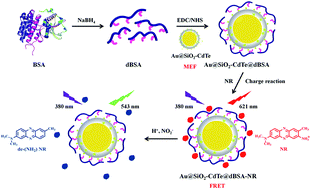A fluorescent nanoprobe based on metal-enhanced fluorescence combined with Förster resonance energy transfer for the trace detection of nitrite ions†
Abstract
Fluorescent nanoprobes have been investigated for the detection of nitrite ions. However, the fluorescence intensity and sensitivity of fluorescent nanoprobes are still restricted by their low quantum yield. A novel fluorescent nanoprobe based on metal-enhanced fluorescence combined with Förster resonance energy transfer was developed for the trace detection of NO2− in this work. 24.8-fold fluorescence enhancement of CdTe QDs was achieved with exact control over the size of Au nanospheres and the thickness of the silica shell between the Au NSs and CdTe quantum dots in the Au@SiO2–CdTe nanoparticles, and coating Au@SiO2–CdTe NPs with denatured bovine serum albumin. The detection of NO2− with the obtained Au@SiO2–CdTe@dBSA-neutral red fluorescent nanoprobe was based on the FRET from CdTe QDs to neutral red. The detection limit of NO2− in aqueous solution was found to be as low as 60 nM, much lower than the maximum permitted concentration of 2.2 μM in drinking water. In addition, the Au@SiO2–CdTe@dBSA-NR fluorescent nanoprobe was successfully applied to the detection of NO2− in real samples and cell supernatants with precise and accurate results.


 Please wait while we load your content...
Please wait while we load your content...